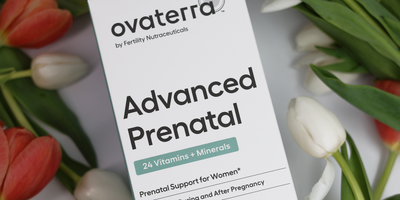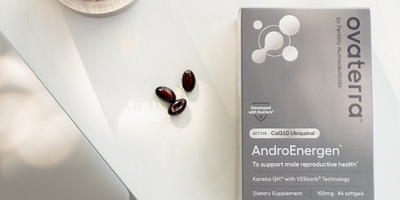Chances are, you’ve seen the phrase “egg quality” come up a lot on your TTC journey. It’s no surprise: Some doctors, including Dr. Norbert Gleicher, Medical Director at the Center for Human Reproduction in New York City and an expert in female reproductive health, say that over 90% of embryo quality comes from the egg, with sperm contributing just a tiny bit, which makes egg quality a major focus on a couple’s reproductive health. But what exactly is egg quality? How do we know if it’s good? And are there ways to influence the quality of your eggs? Let’s dive into the science.
Is egg quality the same as the number of eggs left in the ovaries?
Egg quality is not the same as egg quantity. However, the two do usually go together – as women get older, the number of eggs left in the ovaries go down, and the quality of these remaining eggs also go down. This is why you might read articles that use “egg quality” and “number of eggs a woman has” somewhat interchangeably.
However, it’s important to approach egg quality and egg quantity separately. Currently, there is nothing we can do to increase the number of eggs left in the ovaries as we go through life. (Yes, there are scientists working on growing eggs from ovarian stem cells or from very immature eggs, but those won’t be ready for clinical application for a while.) In contrast, egg quality may be something that you can support, by eating a healthy diet, reducing your exposure to environmental toxins and adopting other lifestyle modifications.
Is egg quality just about the genetics?
Whether an egg is genetically normal or abnormal is an important aspect of egg quality. It’s also a major reason why doctors say egg quality declines with age; as women age, more and more of our eggs carry genetic abnormalities that either make them not viable at all, or result in genetic conditions in the baby, such as Down syndrome.
Each egg carries 23 chromosomes. Eggs that go through the maturation process in the ovaries of older women are more prone to errors that result chromosomal abnormalities. The causes can be multi-faceted: An age-related decline in cellular energy metabolism and accumulation of oxidative damage, among others.
That said, egg quality encompasses more than the number and integrity of the chromosomes in the egg. In fact, two eggs that are perfectly normal from the genetic standpoint can have very different quality indicators, and as a result, fairly different developmental potential.
What do scientists use to measure egg quality?
In contrast to embryo quality, we don't have an agreed-upon set of measures for egg quality. So, scientists have proposed a number of distinct indicators of egg quality, in an effort to standardize how egg quality is measured at different clinics, labs and the like.
Some groups have come up with a scoring system, combining multiple measures, while other studies have focused on each measure’s ability to separately predict the chance of an egg’s ability to become a healthy baby.
As many of the egg quality studies are conducted in the embryology laboratories of fertility centers, measures of egg quality tend to be what lab scientists can observe, including:
- Quality of the cytoplasm: Cytoplasm is the fluid that fills the inside of cells, including egg cells. Color of the cytoplasm, its granularity/texture and presence/absence of debris in the cytoplasm, have been suggested as a measure of egg quality.
- Overall shape and size of the egg cell: Most egg cells are spherical. Some studies have suggested that ovoid eggs are of lesser quality. There is also some evidence that both extremes - either very large or very small - may not be a good sign, when it comes to the egg’s size (diameter).
- Integrity of the first polar body: A polar body is a small cell that separates from the egg during meiosis. It contains a nucleus and a small amount of cytoplasm. Polar bodies usually die off while the eggs continue on their maturation journey. Some studies suggested that fragmentation and other abnormalities in the polar body can signal problems with egg quality.
- Appearance of the zona pellucida: Egg cells are covered in a glycoprotein layer, called zona pellucida. Secreted by both the ovarian follicle and the egg itself, this layer plays an important role in facilitating fertilization – it binds the sperm to the egg. The appearance of zona pellucida, like its color, shape and thickness, has been suggested as a measure of egg quality. How much space there is between zona pellucida and the egg’s membrane, as well as the absence/presence of debris there, have also been suggested as a sign of egg quality.
Studies have conflicting results, however, when it comes to how well each of these characteristics can predict the egg's ability to fertilize and result in a healthy pregnancy. Most of these studies are done with animals or in a fertility treatment setting, raising the question that the results may not be applicable to women with normal reproductive health. Clearly, more studies are needed to establish a universal criteria of egg quality.
Can you test your egg quality?
While the laboratory observations of egg quality isn’t available to most women, there are some blood tests that doctors use to infer egg quality. Ovarian reserve tests like AMH (anti-Mullerian hormone) and FSH (follicle-stimulating hormone), while not a direct measure of egg quality, can give you a clue. When your ovarian reserve is good – indicated by normal AMH and FSH levels – it’s likely that your egg quality is good.
Problems with the “egg quality” narrative
There are several problems with how we measure egg quality. For one, most of the metrics are only available to those of us who receive fertility care. While fertility struggles are common, a majority of women do not access fertility care, so these laboratory observations are out of reach for many.
Furthermore, the measures are subjective, focusing on how a component of an egg looks to an observer. Combined with the lack of agreed-upon criteria, this subjectivity makes it difficult to analyze and compare egg quality, then eventually come up with solutions to improve it.
Framing the roadblock on the journey as a nebulous “egg quality issue” can also be psychologically problematic. When told that they are not getting pregnant because their egg quality is poor, many women end up blaming themselves. But is the doctor retrospectively concluding that the egg quality must be an issue, because a pregnancy didn’t happen? Or is there an objective problem that can be addressed? In the absence of an agreed-upon definition, it’s difficult to know what it really means, and even harder to come up with an action plan.
Can you improve your egg quality?
That said, there are some steps you can take to help support your egg health, based on what we know.
- Avoid activities known to harm eggs: Smoking, for example, is known to harm egg quality. BPA and similar chemicals used in clear plastics are also suspected to reduce egg quality. (And it’s relatively easy to reduce your exposure to BPA to safeguard your fertility.)
- Get plenty of antioxidants: As women age, oxidative damage accumulates, which has been suggested to potentially impact egg quality. Make sure your diet contains plenty of antioxidants, like Vitamin A, Vitamin C and Vitamin E. Studies have shown that the Mediterranean diet is one of the better ways to eat for your fertility.
- Consider supplements to support egg quality: Supplements like coenzyme Q10 (CoQ10) has been suggested as a potential way to support egg health. CoQ10, in particular, may support egg health by balancing out reactive oxygen species (ROS) and supporting cellular energy metabolism.
Egg quality is top-of-mind for many women on the fertility journey, especially for those over 35. More studies are needed to better define the nebulous term and establish a uniform criteria. While we wait, take steps to support your egg health - and please reach out if we can answer any questions. We are with you.















